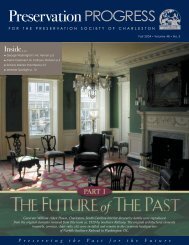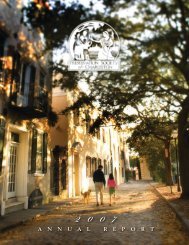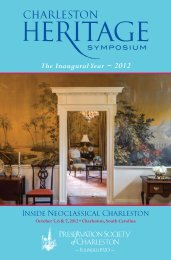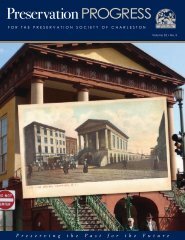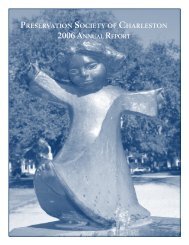download pdf - Preservation Society of Charleston
download pdf - Preservation Society of Charleston
download pdf - Preservation Society of Charleston
- No tags were found...
Create successful ePaper yourself
Turn your PDF publications into a flip-book with our unique Google optimized e-Paper software.
Arrival at the Winterthur Museum.<br />
The last week in March<br />
found <strong>Charleston</strong><br />
bedecked in its finest<br />
springtime garb. Visitors<br />
to the Holy City were<br />
here in record numbers,<br />
according to a report<br />
in the Post and Courier.<br />
Carriages were fully loaded,<br />
attendance at area<br />
attractions was up, and<br />
the city’s streets and sidewalks seemed crowded to near capacity as the allure<br />
<strong>of</strong> <strong>Charleston</strong>’s peak tourist season was clear and evident to one and all. But<br />
springtime in <strong>Charleston</strong> is also when the <strong>Society</strong>’s annual study tour departs<br />
all this seasonal congestion and seeks a soupcon <strong>of</strong> escape and edification<br />
elsewhere.<br />
A very special, insightful day at Winterthur, the former home <strong>of</strong> Henry<br />
Francis duPont (1880-1969) was the centerpiece and one <strong>of</strong> the highlights<br />
<strong>of</strong> the <strong>Society</strong>’s 2006 Spring Tour, which left March 30th and returned on<br />
April 2nd. Eighteen members <strong>of</strong> the<br />
<strong>Preservation</strong> <strong>Society</strong> traveled to the<br />
fabled duPont estate and museum<br />
nestled in the heart <strong>of</strong> Delaware’s<br />
beautiful Brandywine Valley, halfway<br />
between New York City and<br />
Washington, D.C. where an enjoyable<br />
weekend <strong>of</strong> historic architecture,<br />
art, and antiques awaited.<br />
Tom Savage, well-known former<br />
resident <strong>of</strong> <strong>Charleston</strong> and newly<br />
appointed Director <strong>of</strong> Museum<br />
Affairs for Winterthur, hosted the<br />
group for a gala weekend <strong>of</strong> touring<br />
area private homes, enjoying sumptuous<br />
dinners, and visiting several area<br />
gardens at the height <strong>of</strong> their springtime<br />
bloom. Of particular focus was<br />
the <strong>Charleston</strong> connection to many<br />
<strong>of</strong> the people, places, and wonderful objects d’art seen in the vast Winterthur<br />
collection and on the tour. (See article on previous page, “Aunt Rebe”)<br />
Winterthur<br />
STUDY TOUR TO<br />
HAILS THE COMING OF SPRING<br />
Granogue – the duPont family home<br />
and the residence <strong>of</strong> Rebecca Frost<br />
for 48 years.<br />
In Memoriam<br />
<strong>Preservation</strong> PROGRESS 5<br />
H. F. duPont was an avid antiques collector and horticulturist. In his<br />
one lifetime, he created an extraordinary American country estate on par<br />
with English examples that took centuries to evolve. Winterthur has in its<br />
175 rooms and adjacent<br />
galleries an unsurpassed<br />
collection <strong>of</strong> 85,000<br />
objects made or used in<br />
America between 1640<br />
and 1860. Mr. Savage<br />
took the <strong>Society</strong> travelers<br />
on a highlighted tour<br />
<strong>of</strong> the museum’s period<br />
rooms and hosted an<br />
informal luncheon in<br />
the “<strong>Charleston</strong> dining<br />
room,” which<br />
was removed from<br />
the (1774) William<br />
Burroughs House that<br />
originally stood at 71<br />
Broad Street. In 1928,<br />
when the house was<br />
Preparing the authentic hearth cooked lunch<br />
at the Collins-Sharp House (c. 1700)<br />
in Historic Odessa.<br />
being razed, the room was dismantled and sold to a private collector and is<br />
now part <strong>of</strong> Winterthur’s architectural collection.<br />
Also on the weekend’s agenda were visits to several <strong>of</strong> the Brandywine<br />
River Valley’s most exclusive private homes and collections. Some <strong>of</strong> the houses<br />
on the tour were well-known to Miss Rebecca Frost, sister <strong>of</strong> <strong>Preservation</strong><br />
<strong>Society</strong> founder Susan Pringle Frost, who was a long-time friend and close<br />
associate <strong>of</strong> the duPont family.<br />
A major highlight <strong>of</strong> the group’s visit to the village <strong>of</strong> Odessa (formerly<br />
known as Cantwell’s Bridge) was a complete hearth-cooked lunch prepared in<br />
the open fireplace <strong>of</strong> the Collins-Sharp House (c. 1700) now owned and operated<br />
by Winterthur. The hearty three-course meal was prepared according to<br />
authentic 18th and 19th century recipe books once widely used in that area.<br />
Azaleas in riot, redbud gone rampant, wisteria bursting beautifully in<br />
varied shades <strong>of</strong> blue. Yes, this is <strong>Charleston</strong> in spring. But our intrepid wanderers<br />
from the <strong>Preservation</strong> <strong>Society</strong> spring study tour made do with crocus,<br />
daffodils and the breathtaking Sargent cherry blossoms cascading down the<br />
March Bank <strong>of</strong> Winterthur Gardens. Not a bad trade, really. Not bad at all. ■<br />
Elizabeth Agnew Luke



